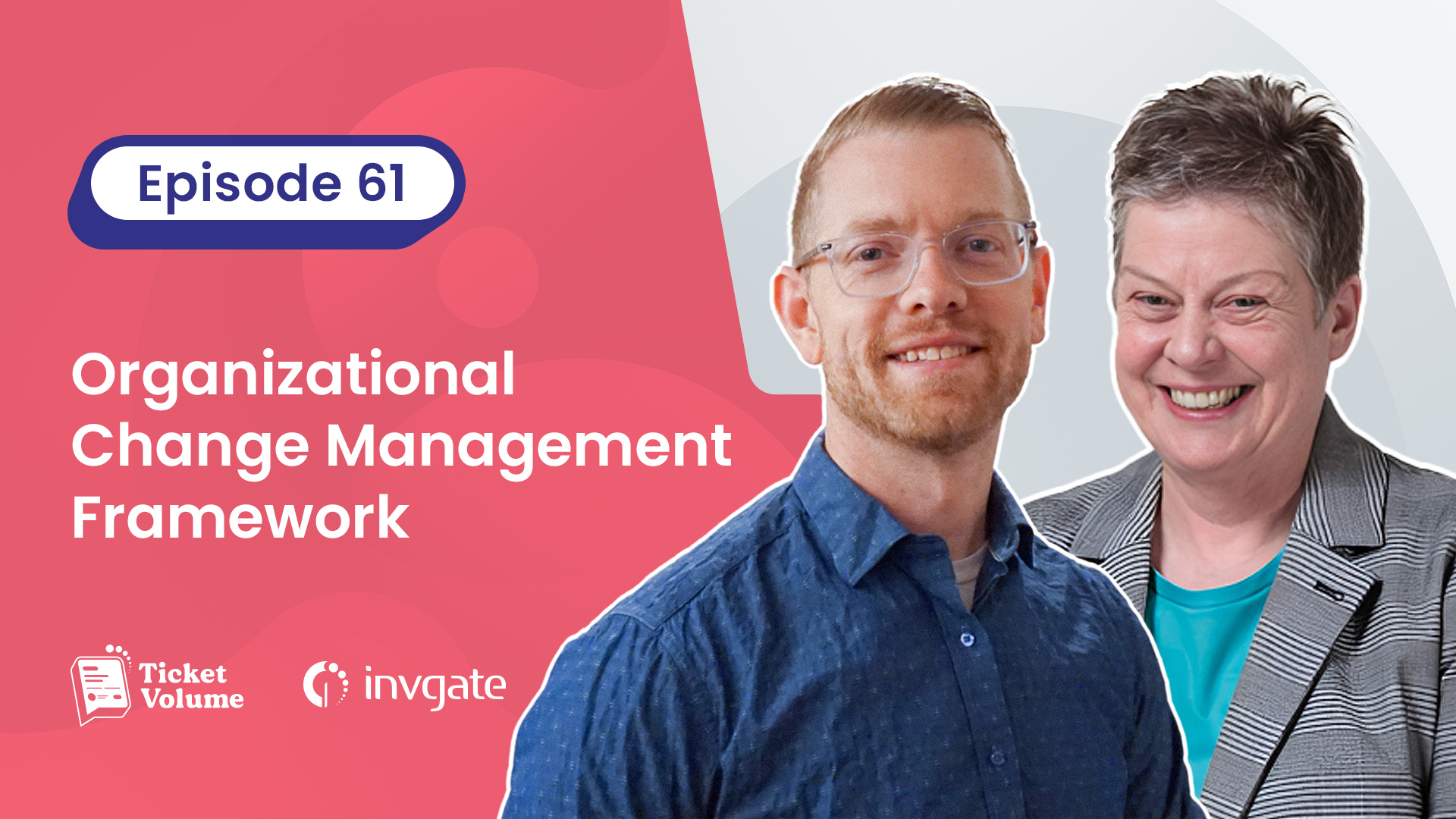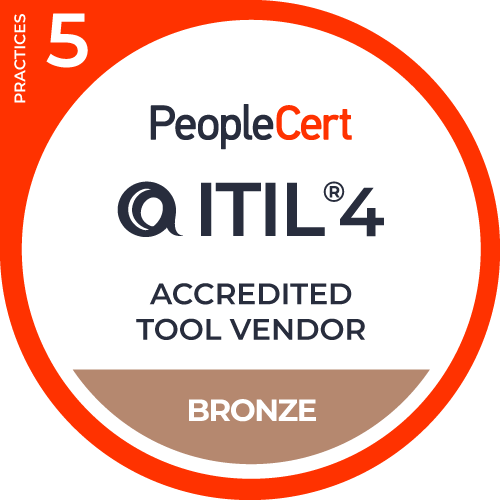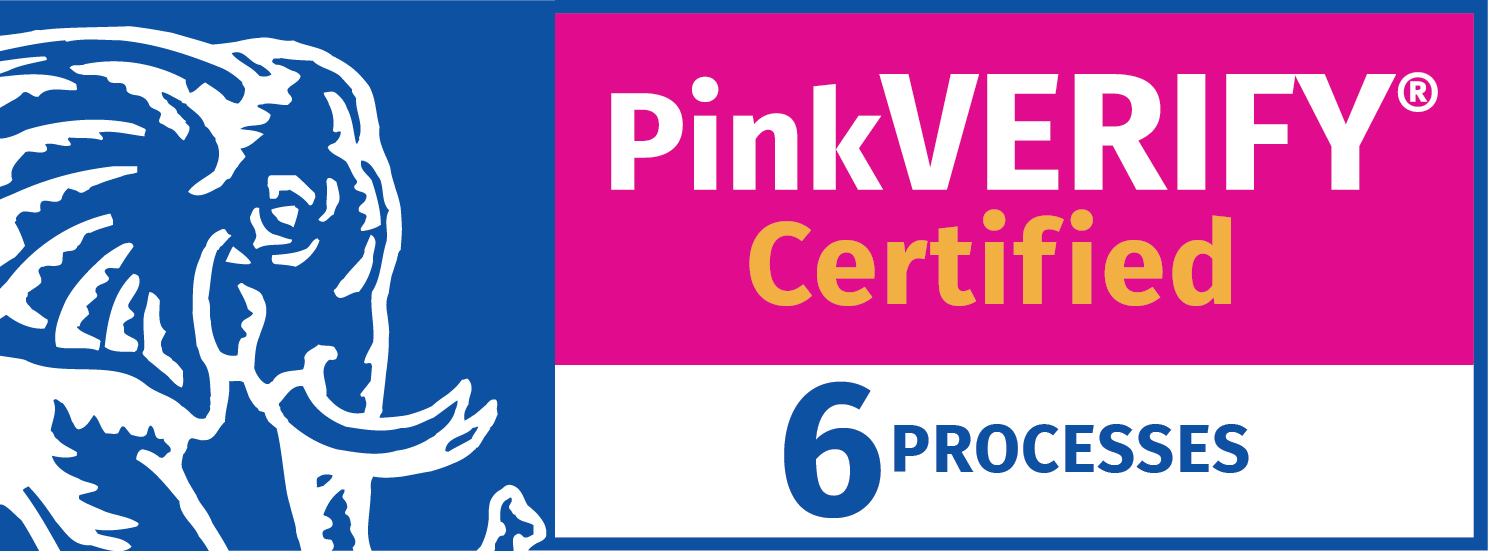The Definitive Guide to Change Management
Explore our comprehensive guide on ITIL 4 Change Enablement, covering benefits, tools, and a comparison with Change Management.

The Definitive Guide to Change Management
Change Management helps organizations manage the complexities of introducing new technologies, processes, or systems. It is an essential part of IT Service Management (ITSM).
Change is a constant in IT—whether to correct an issue that has already arisen, or to prevent future ones from occurring. It’s both about keeping systems compatible with new requirements and enhancing current capabilities to stay competitive.
Whatever the reason, change is rarely simple, and overlooking its complexity can lead to disruptions, inefficiencies, or worse, system failures. That's why IT professionals, change managers, and service desk staff must understand how to manage change effectively to maintain reliable and efficient services.
In this guide, you'll find an overview of the key aspects of Change Management, including its core principles, best practices, and practical steps to implement a process that works. By the end, you’ll have the tools to manage IT changes smoothly and keep your organization on track.
What is Change Management?
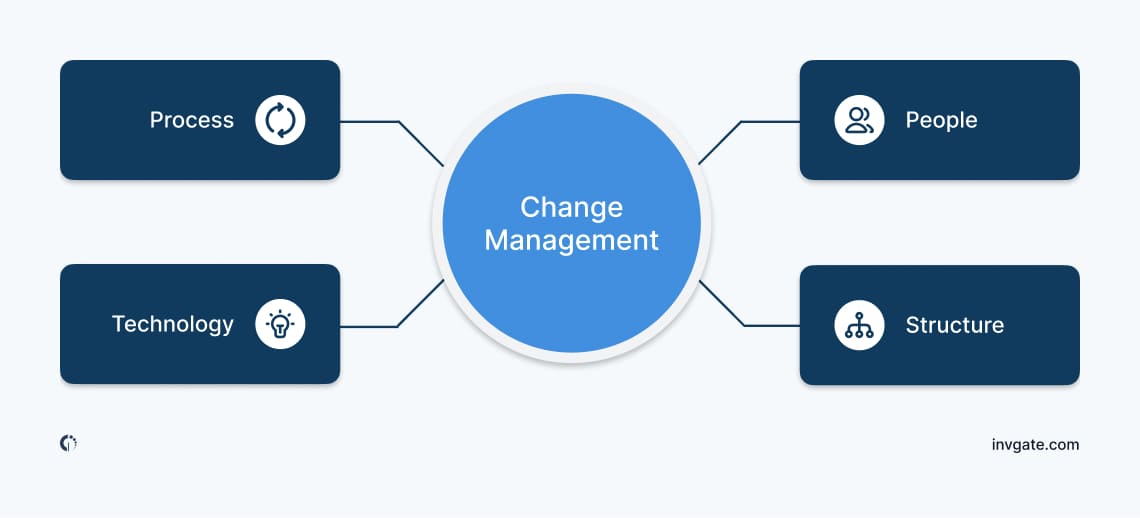
Change Management is the practice of systematically guiding an organization through change, whether it’s introducing new technologies, processes, systems, or shifting organizational structures.
The process involves planning, implementing, monitoring, and reinforcing changes to ensure they are integrated smoothly and achieve the desired outcomes with minimal disruption.
One of the most important aspects of Change Management is the human side of change — thinking in advance about how it will impact people, preparing them for what’s coming, and helping them adapt to new ways of working. That’s why activities like setting clear communication channels, employee training programs, providing support, and gathering feedback are central to Change Management.
Now, you might wonder why we write "Change Management" with capital letters. That's because, in the context of IT Service Management, Change Management is recognized as a formal, structured practice.
It’s not just about managing change in a general sense but involves specific processes, roles, and activities designed to manage IT-related changes effectively. We’ll explore this in more depth in the following sections.
"Change is like a wave, and it's a massive wave. Some are bigger than others, but they'll knock you over if you stand still. It'll take you with it, and you'll go under. And when you try to come up for air and get back on your feet, the next wave comes crashing over you. So, we need to find ways to ride the waves of change. It's about being prepared for it, and that's where Organizational Change Management comes in. OCM needs to fundamentally change the way we prepare people for the next change."
Karren Ferris, Service Management Expert at Macanta Consulting
ITIL change definition
ITIL offers a clear purpose statement for Change Management: “To maximize the number of successful service and product changes by ensuring that risks have been properly assessed, authorizing changes to proceed, and managing the change schedule.”
In this context, the renowned ITSM framework defines a change as “the addition, modification, or removal of anything that could have a direct or indirect effect on services.”
Change Management vs. Change Enablement
This shift goes beyond a simple name update. It introduces a simpler, more flexible approach designed to better align with today’s dynamic IT environments. Change Enablement was designed to be simpler and more flexible than the Change Management approach in ITIL v3/2011.
There are two main processes in ITIL 4 Change Enablement:Change Lifecycle Management:
This process covers the entire journey of a change from start to finish, including:
- Registration: Recording and tracking the change.
- Assessment: Evaluating the potential impact and risks.
- Authorization: Getting approval to proceed.
- Planning: Preparing for the change.
- Realization control: Overseeing the implementation.
- Review and closure: Ensuring the change is successful and formally closing it.
- Change Optimization:
Focuses on continuously improving how changes are managed. This includes refining change practices, models, and procedures to make them more efficient and effective over time.
- Integration with DevOps:
- Safe-to-fail testing: Experimenting in ways that don’t harm the system if something goes wrong.
- Continuous integration and delivery: Regular updates and improvements, often with automation.
- Feedback loops: Constantly learn from the process and make adjustments.
- Simplified roles:
ITIL 4 replaces the traditional Change Advisory Board (CAB) with a new role called “Change Authority.” This role allows for faster, more flexible decision-making, often involving peer reviews or automated processes.
ITSM and Change Management
As part of IT Service Management practices, Change Management is essential for ensuring that changes to the IT infrastructure and services are managed with minimal disruption and maximum effectiveness. It addresses the technical aspects of change and considers the broader impact on the organization, including the people involved.
It’s important to note, before we move on, that Change Management shouldn't be confused with two other ITSM processes:
- Service Request Management: There is often confusion between service requests and change requests. Service requests are typically low-risk and routine, such as password resets or software installations. They should be handled separately from change requests to prevent unnecessary delays and bureaucracy, often using a standard change approach.
- Organizational Change Management: The focus of this practice is somewhat narrower as it looks exclusively at helping people affected by changes. The goal is to prepare them and support them throughout the transition stage.
Change Management goals
Change Management provides a structured approach to transitioning individuals, teams, and organizations from their current state to a desired future state. The main goals are to minimize disruptions during transitions (and the costly downtime or potential fines and penalties that come with it), increase the success rate of changes, and standardize processes for proposing and implementing modifications. The practice also improves visibility across the organization and allows leaders to track and assess the impact of changes.
One paradigmatic case where Change Management plays a critical role is digital transformation, particularly because it requires substantial adjustments not just in technology but also in organizational culture. Change Management guides these transitions by coordinating efforts across different departments, aligning new technologies with business goals, and addressing the human aspects behind adopting new technology.
Another goal of Change Management is to help organizations manage risks associated with major changes. To this end, it offers methods to identify potential problems, develop strategies to address them, and ensure regulatory compliance with industry standards and internal policies. It also helps maintain service quality and operational stability throughout the transformation process.
Benefits of Change Management
Every business needs change, and there are many drivers of change. Some are internal such as new products and services, revised ways of working, mergers and acquisitions, or correcting technology issues. Some are external such as legal or regulatory changes. Organizations need formal change capabilities that balance speed, risks, costs, and business value to deal with this constant flow of change.
- Enhanced change visibility – from communicating the schedule of changes to dealing with quick or emergency changes quickly.
- Increased speed of change – thanks to change models and change-enabling automation.
- More robust risk avoidance and impact assessment.
- Improved change prioritization and scheduling.
- Better resource allocation through careful planning and evaluation of each modification.
- Reduced change-related costs — it can avoid issues and failures caused by failed changes or business disruptions.
The four core principles of Change Management
The four core principles of Change Management work together to create a holistic approach to managing change. These principles provide a straightforward framework for guiding organizational changes. Let’s explore them:1. Understand
This principle involves gaining a comprehensive grasp of the proposed change, its reasons, and its potential impacts. It requires analyzing the current situation, identifying the need for change, and assessing how the change will affect various aspects of the organization and its people.2. Plan
Once the change is understood, careful planning is crucial. This step includes setting clear objectives, defining the scope of the change, identifying potential risks, and developing strategies to mitigate them. It also involves creating a detailed roadmap for implementing the change.3. Implement
In this step, you’ll be putting the plan into action. It involves executing the change in a controlled manner, monitoring progress, and making necessary adjustments along the way. Effective implementation often requires strong leadership and dedication to seeing the change through.4. Communicate
Communication is not just a final step but an ongoing process throughout the change. It involves informing all stakeholders about the change, its progress, and its impacts. Effective communication helps build understanding, reduces resistance, and encourages buy-in from those affected by the change.Top 4 Change Management models
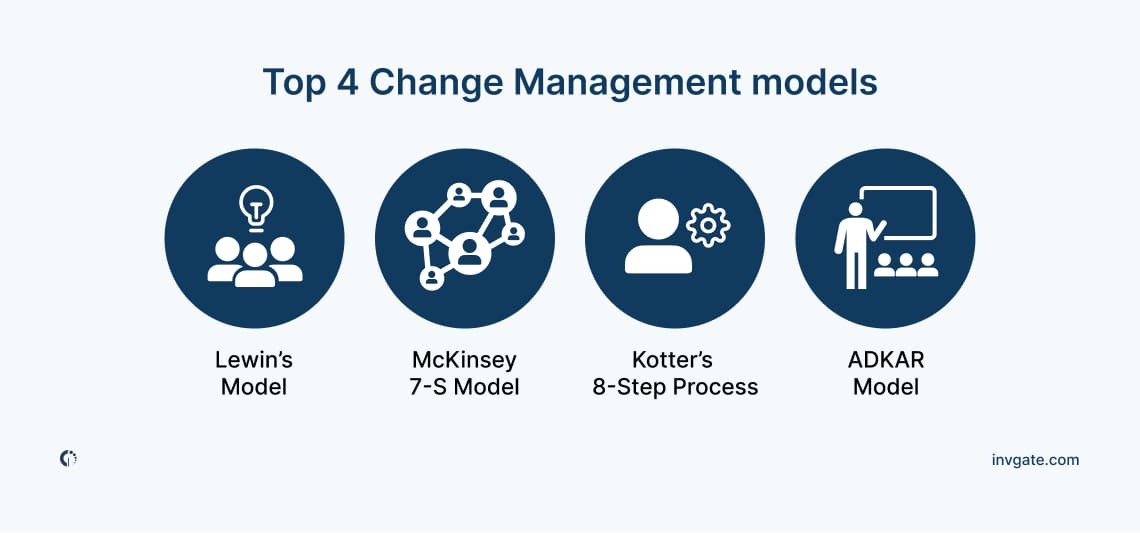
Lewin's Change Management Model
Kurt Lewin, a pioneer in social psychology, introduced this model in the 1940s to address the dynamics of change within organizations. His three-stage model emphasizes the need to prepare for change, implement it effectively, and then ensure the new state becomes stable.- Unfreeze: Prepare the organization for change by challenging the current state and creating a sense of urgency.
- Change: Implement new processes, behaviors, or systems, supporting employees through the transition.
- Refreeze: Solidify the changes to ensure they are adopted and sustained over the long term.
Kotter's 8-Step Process
John Kotter, a professor at Harvard Business School, developed this model after studying why change efforts often fail. His eight-step process is designed to help organizations implement change successfully through good leadership and communication.- Create urgency: Build momentum for change by highlighting its necessity.
- Form a powerful coalition: Assemble a group of influential people to lead the change.
- Create a vision for change: Develop a clear and compelling vision to guide the effort
- Communicate the vision: Share the vision consistently and openly to gain buy-in.
- Remove obstacles: Identify and eliminate barriers to change.
- Create short-term wins: Achieve quick, visible successes to build momentum.
- Build on the change: Continue driving change, reinforcing progress, and preventing regression.
- Anchor the changes in corporate culture: Embed new practices in the organization’s culture for lasting impact.
ADKAR Model
The ADKAR model, introduced by the research and consulting firm Prosci in the late 1990s, focuses on individual change as the key to successful organizational change. It was developed to help organizations understand how change impacts people and to ensure that individual transitions are managed effectively.- Awareness: Recognize the need for change.
- Desire: Show willingness to support and participate in the change.
- Knowledge: Understand how to make the change.
- Ability: Acquire the skills and behaviors required for the change.
- Reinforcement: Ensure the change is maintained over time.
McKinsey 7-S Model
The McKinsey 7-S Model was created by Tom Peters and Robert Waterman, consultants at McKinsey & Company, as a tool to analyze and improve organizational effectiveness. The model highlights the interconnectedness of seven internal elements, ensuring they align to drive successful change.- Strategy: The organization’s plan to achieve its goals.
- Structure: The organizational hierarchy and reporting lines.
- Systems: The processes and workflows within the organization.
- Shared Values: Core beliefs and corporate culture.
- Style: Leadership style and organizational culture.
- Staff: The people and their roles within the organization.
- Skills: The capabilities and competencies of the organization’s employees.
Types of Change Management
1. Organizational Change Management
Approach: Strategic and holistic.
Scope of action: Entire organization, including people, processes, and culture.
Organizational Change Management focuses on aligning an organization's structure, processes, and culture to support a new strategy or direction. This type of change typically involves broad, sweeping changes that impact how the entire organization operates.
The goal is to ensure that all elements of the organization work together to achieve desired outcomes, whether it’s implementing a new business model, merging with another company, or shifting to a different market.
2. Technological Change Management
Approach: Tactical and technical.
Scope of action: IT systems, software, hardware, and related processes.
Technological Change Management is focused on implementing new technologies or upgrading existing ones. This can include anything from rolling out new software systems to upgrading hardware or automating processes. The main challenge here is ensuring that the technology is adopted smoothly by the people who will use it, minimizing disruption and ensuring that the benefits of the technology are fully realized.
3. Transformational Change Management
Approach: Visionary and long-term.
Scope of action: Organizational vision, strategy, and culture.
Transformational Change Management deals with fundamental shifts in an organization’s operations or strategy. This type of change is often driven by external factors, such as market shifts, competition, or regulatory changes. It requires a significant rethinking of the organization’s mission, values, and business model. It typically involves extensive changes to leadership, organizational culture, and employee mindsets to align with a new strategic vision.
4. Remedial Change Management
Approach: Reactive and corrective.
Scope of action: Specific issues, processes, or areas of underperformance.
Remedial Change Management addresses specific problems or inefficiencies within an organization. This approach is often reactive and implemented in response to a crisis or a significant issue, such as declining performance, customer complaints, or regulatory non-compliance. The focus is on identifying the root causes of the problem and implementing targeted changes to correct the issue and prevent recurrence.
5. Developmental Change Management
Approach: Proactive and growth-oriented.
Scope of Action: Skills, processes, and capabilities.
Developmental Change Management focuses on improving and enhancing existing processes, skills, and capabilities within an organization. This type of change is proactive, often initiated to support future growth or to capitalize on new opportunities. It can involve upskilling employees, refining processes, or adopting best practices to improve performance and effectiveness.
6. People-centric Change Management
Approach: Human-focused and empathetic.
Scope of Action: Employee behaviors, attitudes, and engagement.
People-centric Change Management focuses on the human side of change, particularly how changes impact employees. It’s about supporting individuals through transitions, ensuring they are engaged, motivated, and capable of adapting to new ways of working. Some areas to work on are communication, training, and support systems designed to help employees embrace change and perform effectively in the new environment.
Change Management process
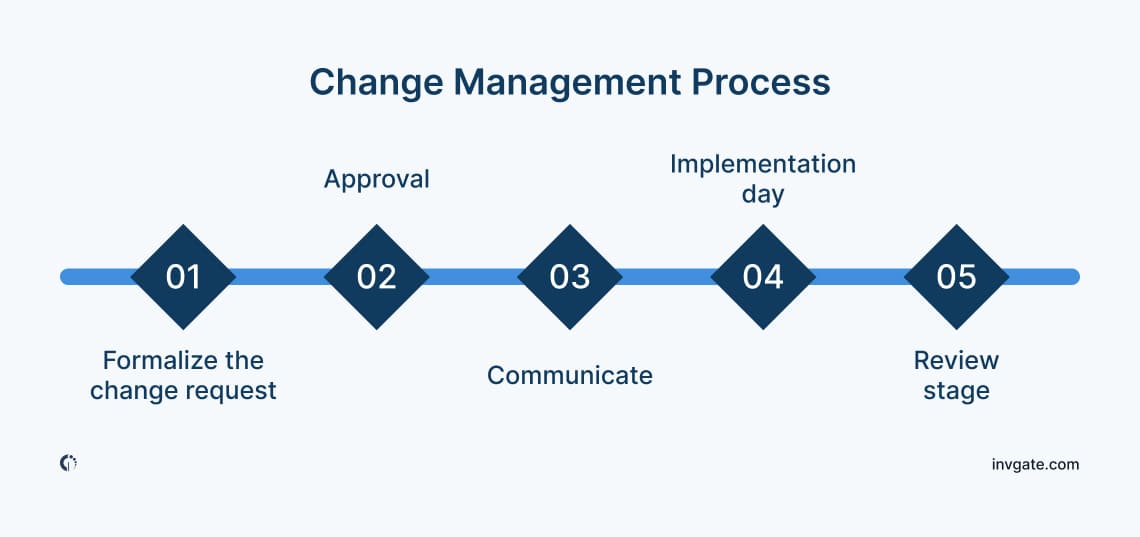
1. Formalize the change request
For your Change Management process, the first thing you'll have to do is establish a formalized method for submitting change requests. Every change proposal must be documented with essential details such as purpose, scope, and potential impact.
At this stage, teams will use a standardized form or template to capture information (we have a free change request workflow template for you to download!) about the nature and urgency of the change, as well as how it aligns with business objectives.
This includes specifying who is responsible for executing the change and ensuring that all relevant stakeholders are identified early on. With all this information, you’ll be ready to proceed with the following steps.
2. Approval
Once the change has been assessed, it needs to be approved. The change manager or team leader can step in to decide whether the change should proceed. The decision is based on several factors, including the potential risks, the resources required, and the overall impact on the organization.
If the change is deemed unnecessary or too risky, the request is closed. However, if it’s approved, the process continues. It’s important to note that this step may involve delegating authority for change decisions to specific individuals or teams, especially for standard changes, in line with ITIL 4 best practices.
3. Communicate
The success of any change initiative will always depend on good communication. Once a change has been approved, it’s time to communicate the plan to everyone involved. This includes all teams and customers who will be impacted by the change. Effective communication ensures that everyone understands what is happening, why it’s happening, and what their role will be during the implementation.
It's important to communicate and get an early buy-in from the teams and people affected by the change. This will help them prepare for the change and reduce resistance. When people understand the reasons behind the change and how it will benefit them or the organization, they’re more likely to support it.
4. Implementation day
Implementation day is when all the preparation comes into play. On this day, the change is implemented according to the plan. If you’ve followed the previous steps, the implementation should proceed smoothly.
During implementation, it’s important to document everything as it happens, including any deviations from the plan. This real-time documentation will be crucial for the review stage and for future reference. For changes that involve significant risk or complexity, it’s advisable to use safe-to-fail testing and have contingency plans ready.
"We need to be learning organizations. We need to craft safe-to-fail and empower people to take calculated risks, so if the goal of Change Management is zero failed changes or zero bad consequences, where's the learning? (...) Safe-to-fail is an engineered thing. We engineer environments, both the technology, how it's managed, how it's deployed in such a way. We believe that any failure is not going to be catastrophic; it will be controlled and limited. (...) We can't allow ourselves to be fighting an organization that wants desperately to learn."
Greg Sanker, Director of IT Support at Taylor Morrison
5. Review stage
The final step in the Change Management process is to review the outcome. After the change has been implemented, take the time to assess its success. Did the change achieve its intended outcomes? Was the implementation process smooth, or were there challenges that needed to be addressed?
The goal is to learn from the experience, measure performance, identify successes, and pinpoint areas for improvement. Even if the change was successful, continuous improvement techniques should be employed to refine the Change Management process over time, ensuring that future changes are handled even more effectively.
Using InvGate Service Management as your Change Management tool
Implementing a robust Change Management process requires the right tools to ensure everything runs smoothly, from planning and communication to implementation and review. Change Management software plays a crucial role in organizing and automating these processes, helping to manage changes efficiently and with minimal disruption.
A perfect way to decide on a Change Management tool is whether it’s certified on this specific practice. And that’s the case for InvGate Service Management! We hold both PeopleCert’s and Pink VERIFIED’s certifications, which endorse our commitment to this process.
Some of the main capabilities that will come in handy to implement it include:
- Customizable workflows: InvGate Service Management’s no-code workflow builder allows you to design workflows that align with your organization's specific needs. The software enables you to route approvals, set up notifications, automate routine tasks, and more. Plus, it offers a pre-built change request workflow template that you can then customize to your own processes, helping you get started in no time.
- Easier communication: The platform facilitates team communication so everyone involved is informed and aligned on the change process. It will help you reduce misunderstandings and enhance collaboration across departments. You can also automate some processes; for example, you can use InvGate Service Management’s API to populate a calendar entry with pertinent change details.
- Tracking and reporting: InvGate Service Management offers dashboards and reporting tools to provide an overview and insights into change progress and impact. Use them to monitor the effectiveness of your Change Management process and identify areas for improvement.
Five best practices to implement Change Management
Here are some key best practices to kick off a Change Management process:1. Establish clear objectives and goals
Before implementing any change, it’s crucial to define what success looks like. Clearly outline the objectives and goals of the change initiative. This helps ensure that everyone involved understands the purpose of the change and what is expected to be achieved. Having measurable goals also provides a way to track progress and adjust strategies as needed.2. Secure leadership support
Change initiatives are more likely to succeed when they have strong support from leadership. Secure buy-in from top executives who can champion the change and provide the necessary resources. Their involvement helps communicate the importance of the change and can motivate employees to engage with the process.3. Develop a communication plan
Effective communication is vital to managing change. Develop a communication plan that outlines how information about the change will be shared with all stakeholders. This includes explaining the reasons for the change, how it will impact employees, and what steps will be taken to support them. Regular updates and open channels for feedback help build trust and reduce resistance.4. Engage stakeholders early
Involve key stakeholders from the beginning of the change process. This includes employees, managers, and anyone else affected by the change. Engaging stakeholders early helps identify potential challenges, gather valuable insights, and build a sense of ownership and commitment to the change.5. Conduct a change impact assessment
Before implementing change, conduct an assessment to understand its potential impact on the organization, processes, and people. Doing this will help you identify areas that will require the most support. It also allows for the development of targeted strategies to address challenges and ensures that resources are allocated effectively.Change Management certifications and training
Pursuing a certification in Change Management can be a great way to deepen your expertise and enhance your career prospects. You can formalize your knowledge and gain practical tools to apply in your organization.
There are several certifications available for different needs and experience levels. Here are some of the top options:
- Certified Change Management Professional (CCMP): Offered by the Association of Change Management Professionals (ACMP), this globally recognized certification requires significant experience and training, making it ideal for seasoned professionals.
- Change Management Specialist (CMS): Provided by the Management and Strategy Institute (MSI), this certification is accessible to all career stages and focuses on practical skills for implementing change.
- Prosci Change Management Certification: A leading program centered on the ADKAR model, this certification combines a three-day workshop with practical tools for managing change, making it popular among professionals.
- Certified Problem and Change Manager (CPCM): Offered by the Global Association for Quality Management (GAQM), this certification covers problem-solving and Change Management with a straightforward online exam process.
- Change Management Certification from Cornell University: This online certification provides a comprehensive overview of Change Management, focusing on stakeholder engagement and communication strategies.
- APMG Change Management Certification: This certification offers foundational and advanced levels, focusing on the principles and practices of organizational change management. It is ideal for team-based change initiatives.
In conclusion
Understanding Change Management is essential for anyone involved in IT Service Management or organizational change. Here are a few key takeaways:- Structured approach: Change Management isn’t just about making changes; it’s about doing so in a way that’s organized, well-planned, and thoroughly communicated to ensure everything goes as smoothly as possible.
- Managing risks: One of the main goals of Change Management is to spot potential risks early, create plans to address them, and keep operations running smoothly even as big changes are happening.
- Aligning people and processes: Successful Change Management requires not just technical adjustments but also addressing the human side of change, ensuring that everyone affected is informed and supported throughout the process.
Frequently Asked Questions
Check out InvGate as your ITSM and ITAM solution
30-day free trial - No credit card needed

